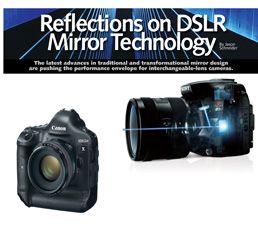
As retailers and consumers marvel at the amazing advances in performance and features in each successive digital SLR that comes down the pike, there are also fascinating and significant developments taking place inside these cameras that are destined to transform what future DSLRs can do, how they work and how they are constructed.
Let’s take a closer look at two recent landmark designs that set the stage for the future of this imaging category and its position in the digital imaging market.
The reflex mirror is the defining feature that spurred the development of modern interchangeable-lens SLR and DSLR camera systems, enabling flexible, parallax-free viewing with virtually any lens up to the instant of exposure. In viewing position, the mirror is held at a 45º angle behind the lens to reflect the image up to the viewing screen.
In today’s optical SLR viewfinders, a pentaprism or penta-mirror placed in between the ground glass or textured plastic viewing screen and the eyepiece turns the image right side up and right way round for convenient viewing and tracking. This simple but brilliant viewing and focusing system, developed over the course of more than half a century, has kept the DSLR and its predecessor, the 35mm SLR, at the forefront, both in terms of technology and marketplace leadership.
However, as soon as you press the shutter release to take the picture, something interesting happens. The ingenious reflex mirror that made all this possible becomes an obstacle that must be moved out of the light path before the shutter fires so the image can be captured on the sensor or film. That’s why reflex mirrors are hinged so they can flip out of the way the instant before the exposure. And that’s also why, ever since the first successful instant-return mirror debuted on the Asahiflex IIb of 1954, engineers have been trying mightily to find effective ways of improving its performance in terms of noise, camera vibration and operating speed, and continue to devise ingenious alternatives.
In the digital era, the venerable reflex mirror has posed other obstacles to progress in achieving faster AF speeds, higher burst rates and enhanced HD video performance, prompting manufacturers to literally think outside the mirror box. Here’s the fascinating story of how two entirely different approaches to the reflex mirror dilemma have recently achieved remarkable real-world results.
Translucent Mirror Technology: Continuous Phase-Detection AF and Blistering Burst Rates, but What Are the Downsides?
Sony’s Translucent Mirror technology, first announced on the Sony A33 and A55, has been further refined in the second generation Translucent Mirror cameras, including the Sony Alpha SLT-A65, SLT-A77 and the new SLT-A57. Both the A77 and A65 have 24.3MP CMOS image sensors and provide: continuous phase-detection AF and AF tracking, even during the exposure; Full HD 1,920×1,080 video at 60p, 60i and 24p; continuous OLED EVF viewing with no mirror blackout; and maximum burst rates of 10 and 12 fps, respectively.
A key to achieving such outstanding specs at competitive price points is the stationary Translucent Mirror that acts as an efficient beam-splitter, directing most of the light straight through to the image sensor, and a much smaller portion of it upward and slightly forward to the phase-detection AF sensor. This enables these cameras to focus quickly and accurately while simultaneously capturing the image, a feat not possible with conventional SLRs and DSLRs with flipping mirrors and optical pentaprism or penta-mirror viewfinders. Needless to say this has momentous implications for still and video capture, and we expect this system to be further developed in the near future.
Sony claims that the second-generation Translucent Mirror used in their latest models was made possible by basic advances in materials technology that allow them to produce semitransparent mirrors with ultra-thin, ultra-smooth, dimensionally stable surfaces having significantly greater flatness (on the order of nanometers) compared to the two-way stationary pellicle mirrors used in older (discontinued) Canon 35mm SLRs, including the landmark Canon Pellix of 1966 and the later, much improved, EOS-1N RS.
These new mirrors are said to virtually eliminate ghosting, completely eliminate the effects of aging, have a minimal effect on image quality and allow a far greater percentage of the light to reach the image sensor. By allowing just enough light to be reflected up to the AF sensor, less than 1/3 of a stop is lost at the image sensor compared to conventional DSLRs, and this is automatically compensated by the cameras’ exposure systems by increasing the signal gain and/or upping the ISO.
Aside from this small but measurable light loss, a relatively insignificant factor given the excellent performance of the latest DSLRs at high ISOs in the 1600 to 6400 range, what are the downsides of Sony’s ingenious Translucent Mirror technology (TMT)? Well, for one thing, by diverting only a minimal percentage of the incoming light upward, Sony effectively ruled out using a traditional optical viewfinder, which means that cameras like the A65 and A77 have OLED EVFs and are technically not true SLRs (because the mirror is not used to reflect the viewing image into an optical viewfinder). Semantics aside, this was probably a wise decision. One of the main reasons Canon’s pellicle-mirror SLRs never caught on was that their pentaprism viewfinders were noticeably dimmer than those in less costly conventional 35mm SLRs of the era.
According to independent testers, any loss in resolution, detail or MTF values attributable to Sony’s TMT falls somewhere between 1% and 5%. Granted these initial data are subject to review, but assuming they’re in the ballpark, the fact that both the A65 and A77 have 24.3MP sensors should at least partially compensate for any slight loss due to the intervening mirror—not to mention the magic of image-processing power, which is very hard to quantify independently. Based on our hands-on experience with the A77, this camera delivers image quality on a par with its middle tier competitors with no noticeable deficit, and may even give a few pro-class cameras a run for the money.
Will Translucent Mirror technology and its variants transform DSLRs into DSLTs? Will other leading camera manufacturers pursue a parallel track, find ingenious new ways to refine traditional DSLRs to provide simultaneous rather than sequential functionality, or take another approach entirely? It’s too early to say for sure, but the next defining moment will probably come when Sony unleashes the full-frame successor to the Alpha 900. Many industry insiders predict it will be a Translucent Mirror camera squarely aimed at pros, and that it will really throw down the gauntlet to other makers.
OLED EVF: It’s What Makes Sony’s TMT a Viable Alternative
Electronic viewfinders (EVFs) that take a live feed off the image sensor and present it through the eyepiece have been around for quite a while, and have been considerably upgraded in recent years by Panasonic, Sony and others to provide better performance. Typical enhancements include greater resolution and faster refresh rates to mitigate smearing of the image when viewing action subjects. To provide a viewing experience more closely approximating an optical SLR viewfinder, Sony came up with the OLED EVF that’s built into the latest Alpha SLRs and the NEX-7 interchangeable-lens compact.
Sony’s OLED EVF uses organic LEDs (self-illuminating OLEDs) to form the image. Its resolution has been increased to an impressive 2.36-million dots for greater detail, and its refresh rate is about 0.1ms, for nearly instantaneous viewing that virtually eliminates smearing when shooting video and action subjects. The OLEDs themselves provide a full RGB signal at each image point without multiplexing, for improved speed and color accuracy. Brightness and color gamut have also been enhanced (a conventional LCD displays 65% of the NTSC color gamut and the OLED covers 20 degrees more on the triangular NTSC color gamut chart).
In addition, the OLED EVF displays a 100% view at 1.1x magnification, is bright to the corners with no light fall off, and has a high eye-point of 27mm for enhanced viewing comfort. Clearly OLED EVFs have considerable upside potential and are, indirectly, the primary feature that makes simultaneous AF, AE and image capture a practical reality. We are already seeing a number of OLED LCDs from manufacturers other than Sony, and it is likely we shall also be seeing more and even better OLED EVFs from many makers in the not too distant future.
Canon’s Astonishing Super-Speed Quad-Action Mirror
When Sony unveiled the SLT-A77, its 12-fps burst rate made it the world’s fastest SLR. Two weeks later, Canon announced the EOS-1D X, a full-frame 18.1MP pro-class DSLR that achieved the same impressive 12-fps burst rate for full-resolution images, provides a brilliant optical pentaprism viewfinder and even shoots at 14 fps with the mirror locked up!
What made this possible is a brilliant, new Quad-Action mechanical mirror design that provides positive mirror actuation in both directions, literally pulling the mirror down and holding it in viewing position, and then pulling it upward, all at incredible speed, while the carbon-fiber shutter fires.
In other words, the system does not rely on springs and that’s why it can reduce the mirror-cycling time from about 80ms in a typical high-speed pro DSLR to a mere 50ms. This technical achievement comes at a price of course—the street price of an EOS-1D X, body only, is $6,799.
However, it’s a clear indication that there is more that can still be done to enhance the performance parameters of the classic optical-mechanical DSLR, and the top-of-the-line EOS-1D X has a lot more up its sleeve, such as a state-of-the-art 100,000-pixel RGB metering system that provides superior subject identification and exposure accuracy when shooting extreme action.





